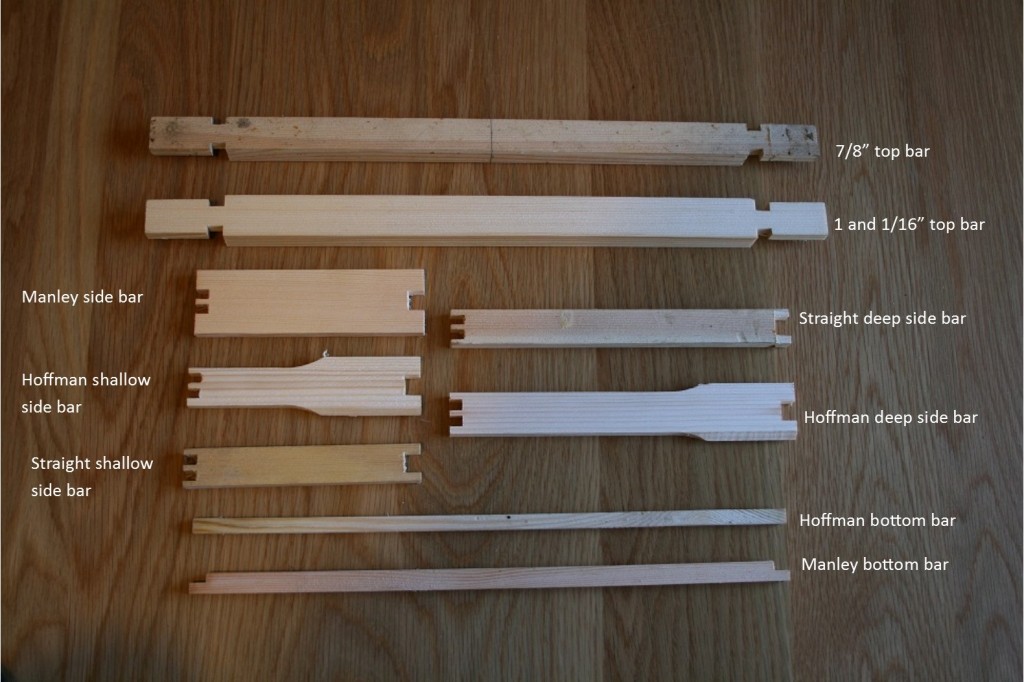There is a lot of bewilderment over which frames to use but there shouldn’t be. Once you understand what the different types are designed to do, the confusion is gone.
In this part of the world we tend to use either National or Commercial hives. Either way, the same principles apply – the only difference being the length of the lugs – that’s the bit you get hold of.
Basically there are two types of frame: Manley or Hoffman. Both are defined by their side bars.
You will sometimes see straight, narrow side bars which are neither Hoffman nor Manley – avoid them because you will need to consider how to space them and it’s not worth it in my opinion. Trust me – I’ve been there.
Here’s a picture of some parts – click it for a better view
Hoffman Frames
Hoffman frames are self-spacing. The side bars are tapered from top to bottom – measuring 1 and 3/8″ at the top which is the spacing required for frames in the brood box.
The edges of each side bar have one flat face and one wedge shaped face. When they have been properly made, the wedges meet the flats of the neighbouring frames and this prevents the bees from gluing them too firmly together with propolis.
The top bar can be either 7/8″ or 1 and 1/16″ wide but this does not affect the spacing. Traditionally it was the latter, but the broader bar seems to discourage the bees from building burr comb to narrow the gap. This has implications for the modern beekeeper who must now carry out midwinter oxalic acid trickle treatment – then the burr comb can be a hindrance so the less of that stuff the better.
Generally a wooden brood box will hold 11 Hoffman frames and one dummy board or – depending on the interior dimensions of your particular box (they do vary) – it may hold 12 at a push. It’s up to you whether you want them tight or loose but remember, mid season the queen may be on the back frame and may get ‘rolled’ when you drag that tight back frame out.
Poly boxes vary as to how many frames they will hold.
Hoffman frames are also available as shallows but only get these if you are considering running what is known as a ‘One and a half’ system.
Manley Frames
Manley frames are designed especially for supers – for honey in other words.
The side bars measure 1 and 5/8″ across so the spacing is 1/4″ wider than Hoffmans. The reason for this is to encourage the bees to draw the wax out further.
Manley frames also have special broad bottom bars and you always use the broader top bar. Together these form a boxlike frame which reduces the amount of wax the bees have to draw and maximises honey space.
Each frame holds very much more honey as a result and you will have less uncapping to do.
The bees will glue the flat faces of these side bars on adjacent frames together quite firmly but you wouldn’t normally be manipulating these frames as you would in a brood box
Wooden supers hold 10 Manley frames. Poly supers vary – those with very thick walls will hold only 9 frames.
Copyright © Beespoke.info, 2015. All Rights Reserved.


I was given frames that have a plastic comb base and frames that have nothing and also, frames that have thin wire across the inside. What is the difference and what do I use each for?
Now that’s a tricky one!
Some say the bees don’t like plastic foundation, others say it’s fine. I don’t know, I’ve never used it and never would. I don’t like plastic – there are always chemicals and bees have enough problems already.
Frames with nothing in them need to be fitted with beeswax foundation – either wired or unwired. Wired foundation doesn’t sag and is stronger and less likely to break in the extractor. Alternatively you could fit them with 4cm starter strips then the bees will draw wild comb.
Frames with thin wires across can be fitted with unwired beeswax foundation then the wire is embedded into the wax using either a heated embedding tool or by passing an electric current through the wires.
If your frames are deeps, they are for the brood box.
If they are shallow, they are for the supers.
Or they could be Rose hive frames in which case they will suit both.
Without seeing them I can’t be more help.
I need to know the the advantages and disadvantages of using a wider frame and also the measurements of both please can you help
The measurements of the two types of top bar are marked in the illustration above and in the text.
Advantages and disadvantages. The fatter bars reduce the gap between frame tops at standard brood box spacing from approximately 13mm to 8mm. This narrower gap is close to a bee-space so the bees are less inclined to close it with brace comb. Whether this is an advantage or a disadvantage depends on how you view the continual build-up of brace comb – is it a nuisance to keep removing it or do you regard it as a crop?
Another thing to think about is the price. Thornes will charge 76p for the narrow top bar aka DN1 or £1.00 for a wide top bar aka (DN2) https://www.thorne.co.uk/frames-and-foundations/frames/frame-parts/bs-frame-parts
Again whether that is too much to pay depends on you and your beekeeping. Like a lot of other things it’s down to personal preference and of course your bees and the way they are.
Thank you, very helpful post
Use straight shallow and deep sidebar frames with castellated frame runners
But why…?
That cleared up which frames I need for my super., from now on. Thanks.